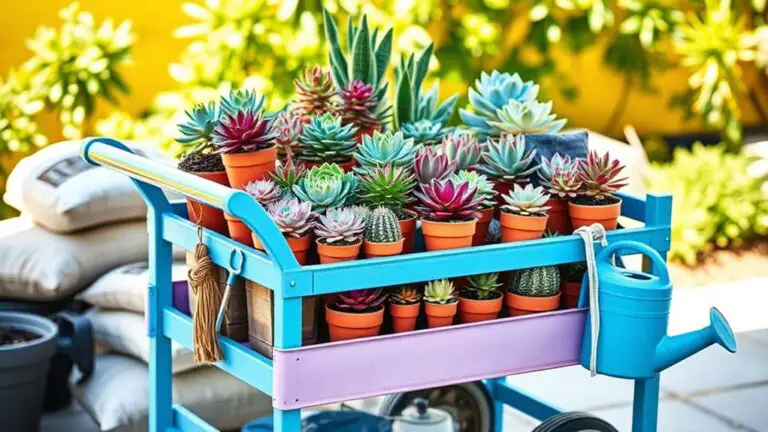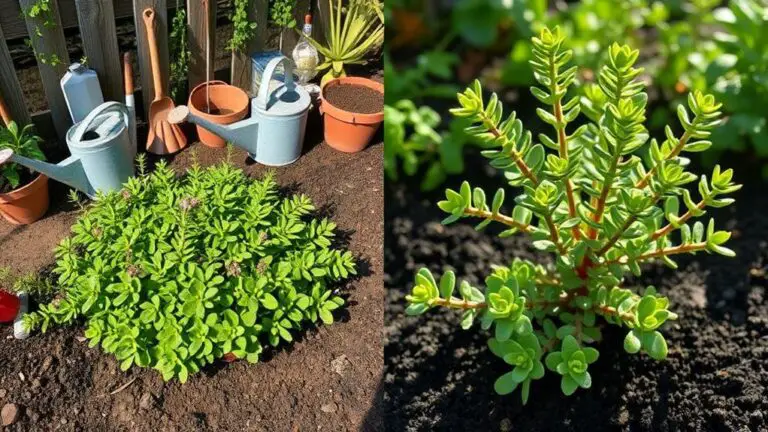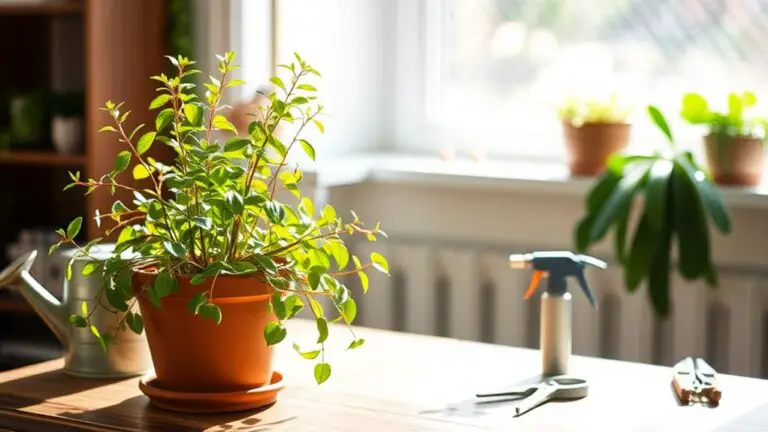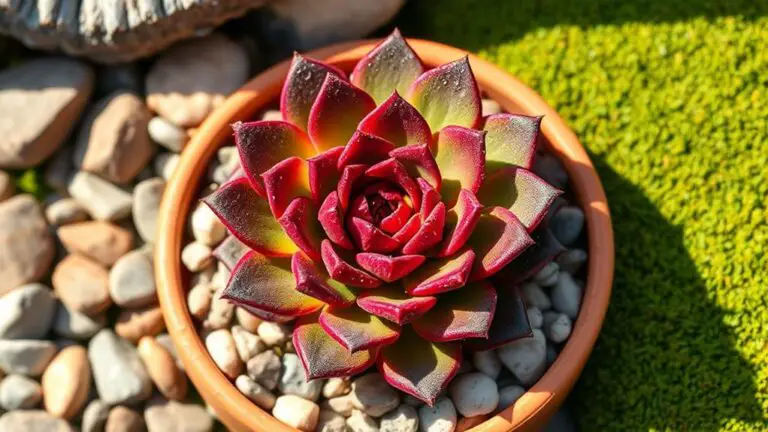Moonstones Pachyphytum Oviferum Care Tips for Beginners
If you're starting out with Moonstones, also known as Pachyphytum oviferum, you'll need to grasp a few essential care tips to keep these succulents thriving. They demand plenty of sunlight, so placing them near a south-facing window is ideal. Watering can be tricky, as too much leads to root rot; only water when the top four inches of soil are bone dry. The right soil and pot are important too. You'll want to know how to avoid common pitfalls and guarantee your Moonstones grow healthy and vibrant. Ready to explore more about creating the perfect environment for them?
Optimal Light Conditions
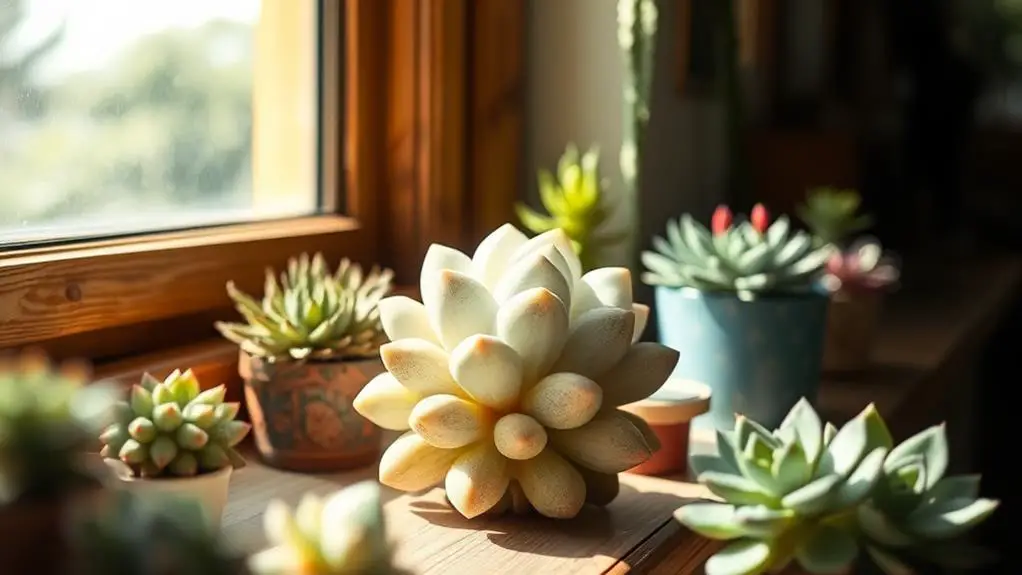
When it comes to Moonstone succulents, getting the light conditions just right is crucial for their health and vibrancy. Pachyphytum Oviferum thrives in bright, direct sunlight, needing at least 6 hours of daily exposure.
Place your plant near a south-facing window to guarantee ideal light conditions. However, be cautious of excessive sunlight, especially in the afternoon, as it can cause leaf sunburn. Providing dappled shade during hot climates can prevent this.
If you notice long stems and fading leaves, your plant might be getting insufficient light. Adjust its location for better illumination.
Don't forget to rotate the pot regularly to guarantee even light distribution, helping your Moonstone succulent grow evenly and beautifully.
Temperature Requirements
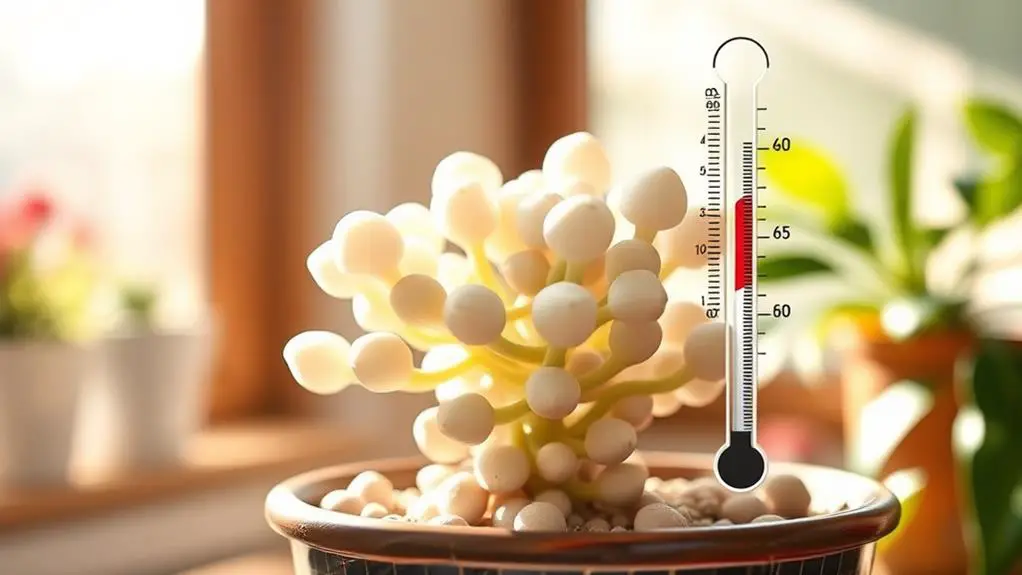
When it comes to temperature, Moonstone succulents prefer a range of 60°F to 80°F, which makes them perfect for indoor spaces.
They can handle brief cold snaps down to 20°F, but anything colder can harm them, so it's important to keep them away from frost.
Stable temperatures are key to their health, so try to avoid sudden changes and protect them from chilly nighttime air.
Ideal Temperature Range
Maintaining the right temperature is essential for the health of your Pachyphytum oviferum, commonly known as Moonstones.
These succulents thrive in an ideal temperature range of 60°F to 80°F for peak growth. They can handle cooler nighttime temperatures, which can actually boost their liveliness.
However, it's important to protect your plant from temperatures below 20°F, as this can be fatal. Also, sudden temperature fluctuations can stress your Moonstones, so try to keep conditions stable.
If frost is a concern, it's critical to move your plant indoors or provide adequate protection.
Seasonal Temperature Changes
Adapting to seasonal temperature changes is essential for the well-being of your Pachyphytum oviferum. This succulent thrives in temperatures between 60°F to 80°F (15°C to 27°C) and enjoys cooler nights for ideal growth.
However, sudden temperature changes can shock your plant, affecting its liveliness and coloration. Pachyphytum Oviferum can tolerate temperatures as low as 20°F, but going below this can lead to plant death.
It's important to protect it from frost, as even brief exposure can cause severe damage. During summer, if temperatures soar, consider moving your plant indoors to avoid stress from extreme heat.
Frost Protection Tips
Protecting your Pachyphytum oviferum from frost is essential to guarantee its survival and health. This frost-sensitive plant can't handle temperatures dropping below 20°F.
When cold weather hits, cover your outdoor Moonstones with frost cloth or bring them inside, ensuring they stay in a stable environment above freezing. Make sure indoor spots are away from drafty windows or doors to avoid sudden cold air exposure.
If your Moonstones are planted outdoors, add a mulch layer around the base to keep the roots warm. Always keep an eye on local weather forecasts, so you're ready to protect your plant from unexpected frost.
Watering Guidelines
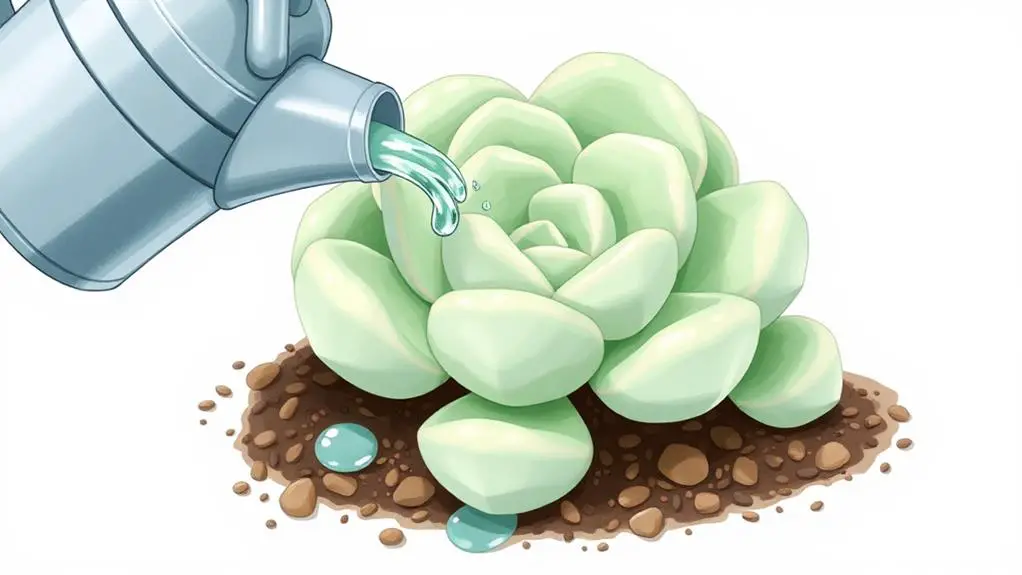
When it comes to watering your moonstones, it's essential to wait until the topsoil is completely dry, usually every 12 days.
This helps prevent root rot and keeps your plant healthy.
Make certain the soil dries out to about 4 inches deep before you water again, as this guarantees you're meeting your plant's moisture needs accurately.
Proper Watering Frequency
Watering your Pachyphytum Oviferum, also known as Moonstones, correctly is essential to keeping it healthy and vibrant.
To water your succulent properly, make sure the soil is completely dry before adding more water. This usually means watering every 12 days. Overwatering can lead to root rot, so always check the soil first. Firm leaves mean your plant has enough moisture, while soft or wrinkly leaves indicate it's time to water.
When you do water, make sure to soak the soil thoroughly until water drains from the pot. Use well-draining soil to prevent water from sitting too long.
During winter, when the plant actively grows, you might need to water a bit more frequently. Prioritize soil dryness first.
Soil Moisture Levels
Keeping an eye on soil moisture levels is essential for the health of your Pachyphytum Oviferum. Water your plant only when the top 4 inches of soil are completely dry. This prevents root rot and promotes healthy growth. Use well-draining soil and pots with drainage holes to avoid overwatering. Firm leaves mean your plant has enough water, while soft or wrinkly leaves signal it's thirsty. During winter, you might need to water every 12 days, depending on conditions. Overwatering can cause squishy leaves and black spots.
| Soil Condition | Action | Indicator |
|---|---|---|
| Top 4 inches dry | Water your plant | Firm, plump leaves |
| Soil still wet | Wait to water | Leaves stay firm |
| Soft or wrinkly leaves | Increase watering | Soil moisture low |
| Squishy leaves, spots | Avoid overwatering | Too much moisture |
| Well-draining soil used | Prevents root rot | Healthy plant |
Soil and Potting Mix
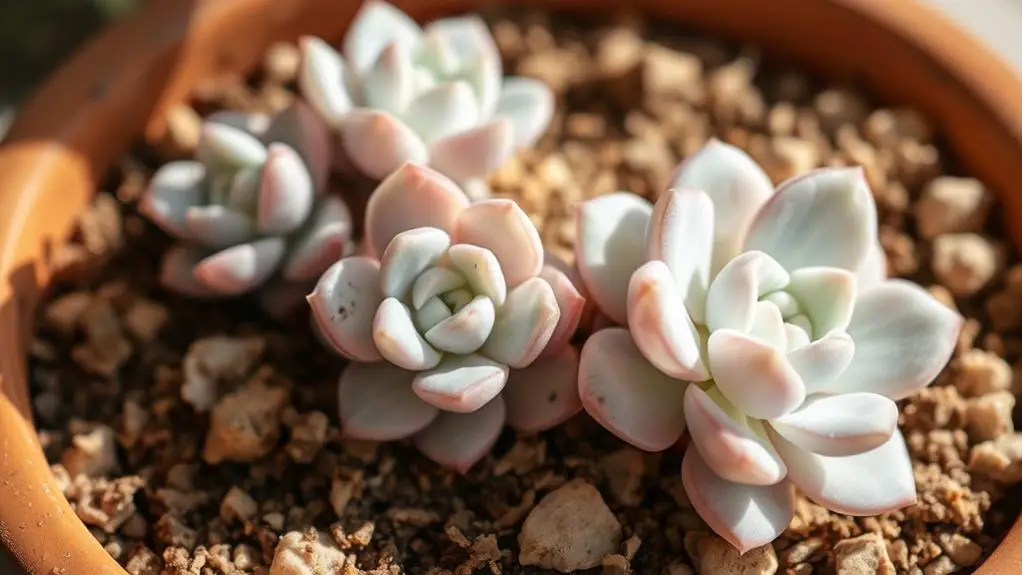
For thriving Moonstones (Pachyphytum Oviferum), a well-draining potting mix is essential.
Start by combining regular potting soil with perlite or sand to prevent water from accumulating around the roots, which reduces the risk of root rot.
Make sure to use pots with drainage holes to enhance airflow and let excess water escape.
When repotting, choose a pot that's 1-2 inches larger than the current one to allow for growth without retaining excess moisture.
- Mix equal parts compost and sand or pumice for outdoor soil preparation.
- Regularly check soil moisture levels; it should dry completely between waterings.
- A well-draining mix helps your succulent thrive.
- Proper drainage prevents root rot and promotes healthy growth.
Planting Indoors and Outdoors
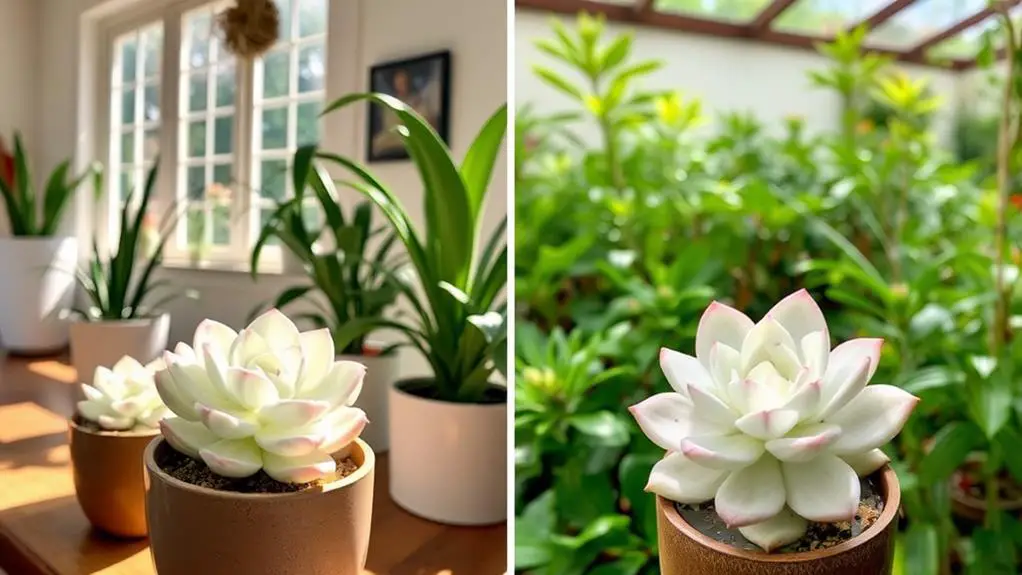
Having established the importance of a proper soil and potting mix, let's move on to the specifics of planting Moonstones both indoors and outdoors.
When planting your Moonstone indoors, use a container with drainage holes and fill it with a well-draining succulent potting mix. Confirm the pot suits the plant's size.
Outdoors, choose a sunny spot that gets full sunlight year-round, providing afternoon shade during extremely hot summers. Prepare the soil by mixing equal parts compost and sand or pumice.
Water both indoor and outdoor plants only when the topsoil is dry. It's crucial to check soil moisture to avoid root rot. If temperatures drop below 20°F, cover them or bring them indoors to protect them from frost.
Repotting Tips

Repotting your Moonstone succulent, or Pachyphytum Oviferum, every two years or less is vital for its health and growth.
Start by choosing a pot that's 1-2 inches larger than the current one. Confirm it has drainage holes to prevent moisture buildup, which protects the roots.
Use a well-draining soil mix, combining potting soil with perlite or sand. This supports healthy root development and maintains the plant's compact shape.
Monitor your Moonstone regularly. Signs it needs repotting include roots emerging from the drainage holes or stunted growth.
- Pick a pot with drainage holes.
- Use a mix of potting soil and perlite or sand.
- Repot every two years or less.
- Watch for roots appearing from drainage holes.
Common Pests and Solutions
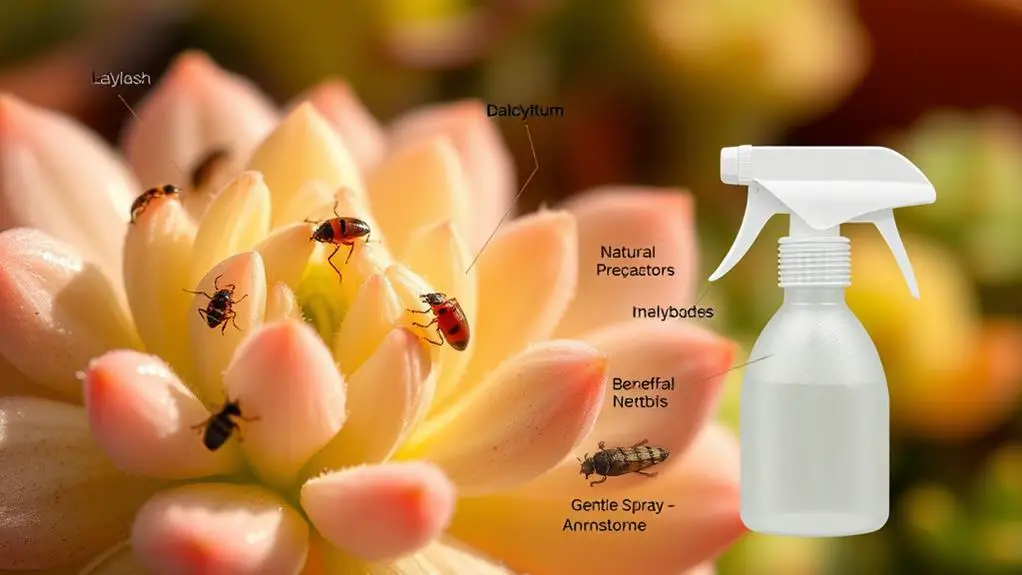
While repotting guarantees your Moonstone succulent has ample space to grow, keeping it pest-free is equally important for its health. Mealybugs, with their white, cotton-like appearance, are the most common pests. For minor infestations, use a cotton swab dipped in diluted isopropyl alcohol to gently wipe the affected areas. Severe infestations may need a stronger solution of 10-25% isopropyl alcohol, applied weekly.
Regularly inspect the plant's roots and foliage, especially if it appears limp without signs of overwatering. Maintaining proper growing conditions, like adequate light and moisture, helps prevent future infestations. Here's a quick reference:
| Pest | Solution | Frequency |
|---|---|---|
| Mealybugs | Cotton swab dipped in alcohol | As needed |
| Severe | 10-25% isopropyl alcohol | Weekly |
| Inspection | Check roots and foliage | Regularly |
| Prevention | Adequate light and moisture | Ongoing |
Frequently Asked Questions
How to Care for Moonstones Pachyphytum?
Place Moonstones in bright, indirect sunlight for at least 6 hours daily. Water only when the topsoil is dry. Use well-draining soil, maintain temperatures between 60°F to 80°F, and regularly check for mealybugs.
How Often Should You Water a Pachyphytum?
You should water a Pachyphytum only when the top 4 inches of soil are completely dry, usually every 12 days. Check the leaves; firm ones mean enough moisture, while soft or wrinkly leaves suggest it needs watering.
How Much Light Does Pachyphytum Need?
You should guarantee your Pachyphytum gets at least 6 hours of bright, direct sunlight daily. Morning sunlight works best, but avoid too much afternoon sun to prevent leaf burn. Rotate the pot regularly for even growth.
How Much Light Does a Moonstone Need?
You'll need to give your Moonstone at least 6 hours of bright, direct sunlight daily. Position it near a south-facing window. In very hot regions, provide some afternoon shade to avoid leaf sunburn and damage.
Conclusion
Taking care of Moonstones (Pachyphytum oviferum) might seem tricky at first, but with the right tips, you'll do great! Remember to give them plenty of sunlight, water them only when the soil is dry, and keep them at a comfortable temperature. Use well-draining soil and check for pests regularly. Whether you're planting indoors or outdoors, these steps will help your Moonstones thrive. You've got this, and your plants will thank you for the care!



